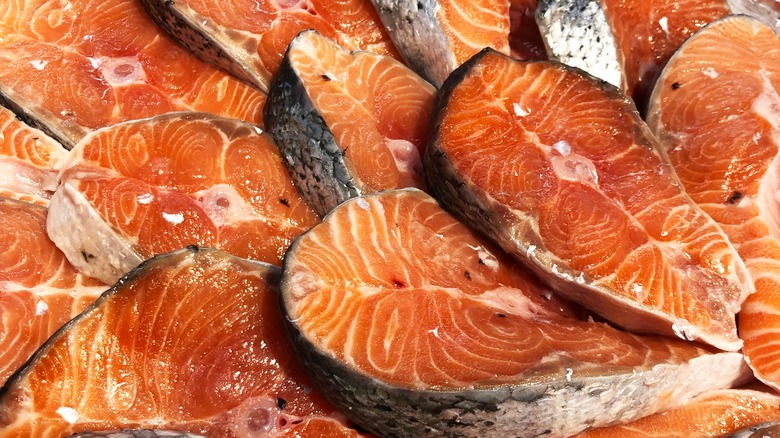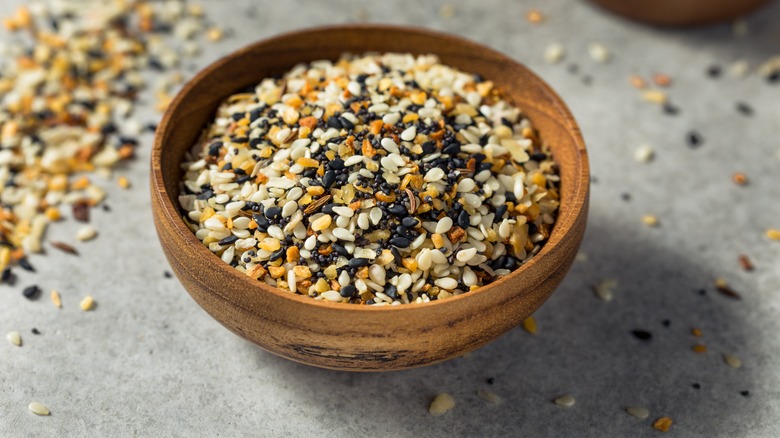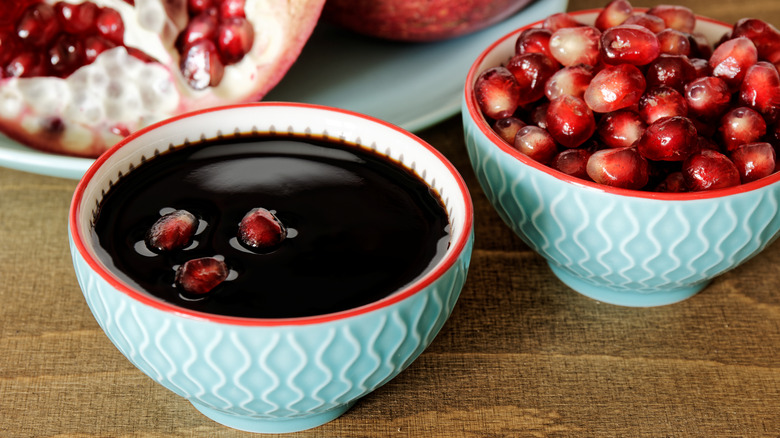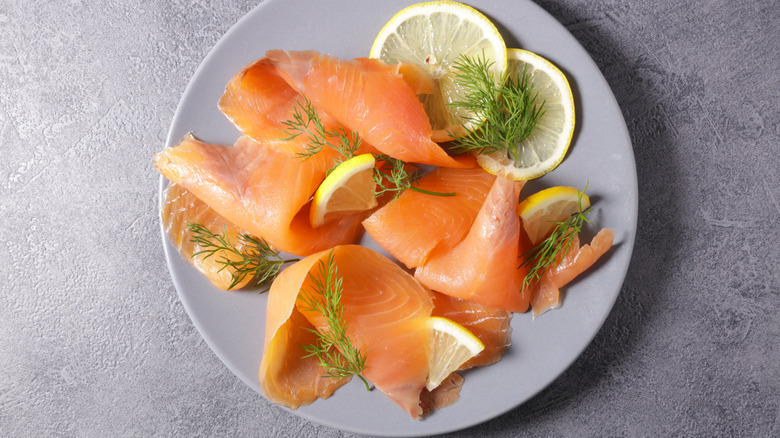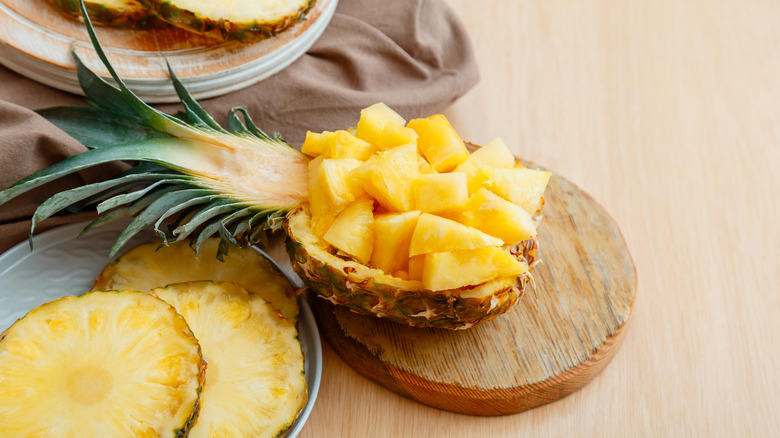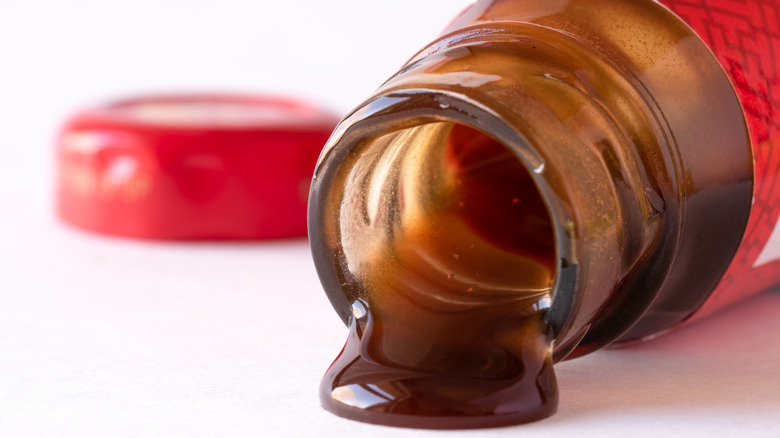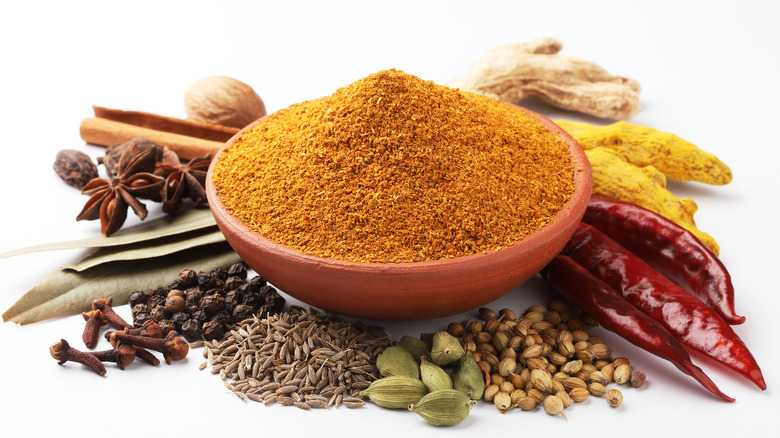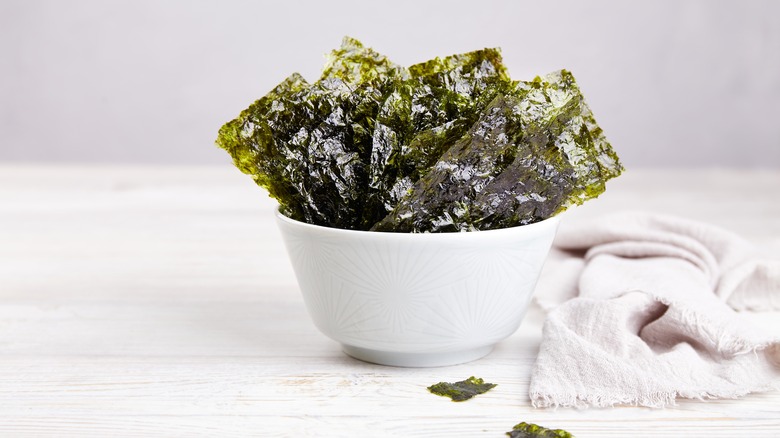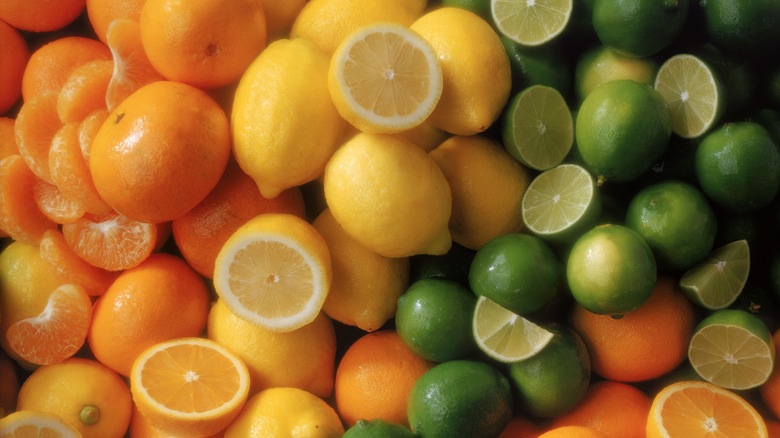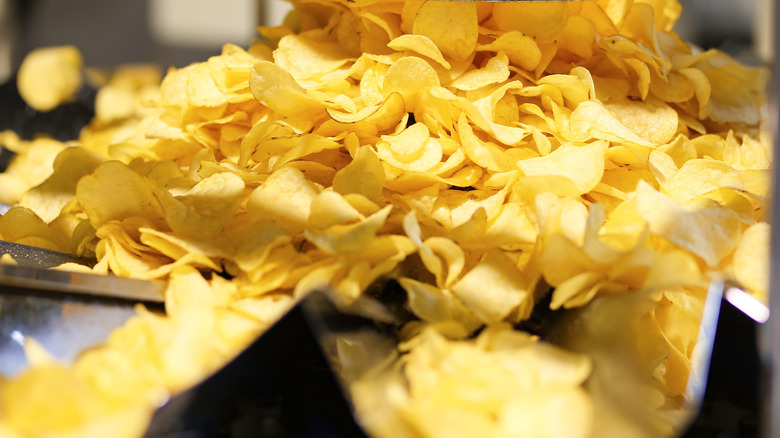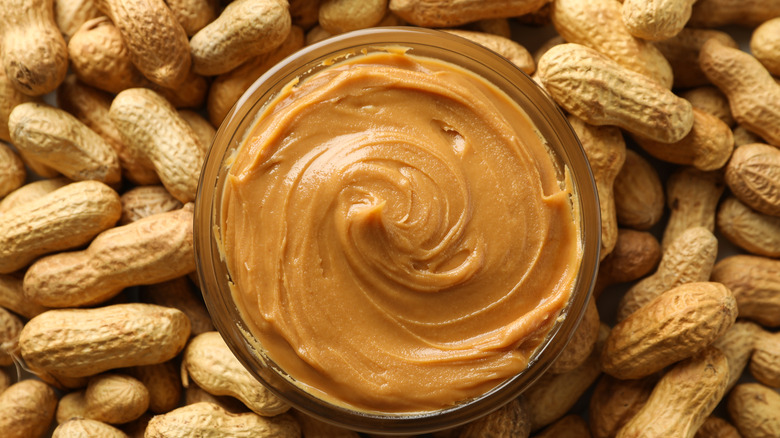11 Unusual Things You Should Be Putting On Your Salmon
Salmon is in the regular rotation of many home cooks because it can be dressed up or dressed down — whether it's casual croquettes of canned salmon for a weeknight dinner or a carefully poached whole side of salmon for an elegant dinner party, it's always welcomed. And besides being tasty, it's easy to find in most areas as well as reasonably affordable, if you shop with care. Even better, it's a nutritional powerhouse, full of omega-3 fatty acids, which are known to both promote heart health and reduce the risk of brain conditions such as Alzheimer's disease, depression, and multiple sclerosis.
But salmon is also easy to take for granted. It's one of those ingredients that's common enough that most of us have a dependable, back-pocket recipe for preparing it. But because it's a bit pricier than dinner-table staples such as ground beef, many cooks don't feel comfortable experimenting with it and potentially ruining their meal. As a result, their salmon feasts — while still delicious — may also become a bit predictable. If this sounds like you, we're here to help. Salmon pairs well with way more varied flavorings than you might think — and you'll be happy to discover that with just a few simple ingredient swaps and little or no extra work, you can take your salmon game to a whole new level.
1. Everything seasoning
When Trader Joe's launched its everything seasoning in 2017, curious cooks and eaters took notice. The crunchy, savory mixture of poppy seeds, sesame seeds, dried onion, dried garlic, and salt — the same mixture that graces the tops of everything bagels — was an instant hit. Home bakers quickly realized it was a great topping for homemade buns and biscuits, and busy cooks discovered it was a great addition to dishes ranging from macaroni and cheese to martinis. And since then, pretty much every self-respecting spice manufacturer has come out with its own version of everything seasoning.
If you are one of the many cooks who have a bottle of it in your pantry, you're only minutes away from a delightfully different salmon dinner. Cut skinned salmon filets into serving-sized pieces and arrange them skinned-side down on a parchment-lined baking sheet. Spread the tops of the filets with mustard thinned with a bit of olive or avocado oil. Sprinkle tops generously with everything seasoning, then bake salmon in a 425-degree oven for 12-14 minutes. It's not only easy but a fun way to bring the flavors of an everything bagel topped with lox to your dinner table.
2. Pomegranate molasses
One reason salmon is so popular is it's a rich, fatty fish with a buttery mouthfeel. As a result, it can stand up to and complement strong, distinctive flavorings, including sweet or spicy ones that might overwhelm more delicate fish. Another reason for salmon's appeal is its pretty pink color, which makes it pop on a plate. So if you're looking for a totally out-of-the-box way to play up both of these distinctive characteristics, consider glazing your salmon with pomegranate molasses.
In case you're not familiar with it, pomegranate molasses is a popular Middle Eastern cooking ingredient made by reducing pomegranate juice to a thick syrup (though it's not as thick or sticky as the more familiar sugarcane molasses). The resulting condiment has a dark red color, with a tart-sweet fruity flavor and aroma. While it's available bottled in Middle Eastern stores and well-stocked supermarkets, you can also make pomegranate molasses yourself by reducing bottled pomegranate juice on the stove and sweetening it. Its color and flavor make it a tasty and eye-catching glaze for salmon filets — but to avoid burning the glaze, don't brush it onto the salmon until it's about halfway cooked.
3. Wood smoke
Salmon thrive in the cold waters of the Pacific Northwest, and native peoples there have long depended on it as a nutritious and flavorful food source. To preserve salmon for long-term use, they dried or smoked it — one traditional method involved exposing salmon filets to wood smoke for two to three days. This not only made the salmon shelf-stable, but enhanced its flavor; and today, modern native tribes in the Northwest have enhanced the bare-bones traditional method by bringing the salmon in a mixture containing salt, brown sugar, and spices, including ginger and allspice, before smoking to create a sweet-salty treat formerly referred to as "Indian candy." Since then, cooks and diners of all backgrounds have discovered that smoke and salmon make a wonderful pairing, and if you're handy with a grill, you can hot-smoke salmon at home.
If you don't have a smoker — or are working with only a few servings of salmon — try cedar plank-baked salmon instead. As the name implies, the dish involves filets of salmon baked or grilled directly on top of a cedar plank, which imparts a woodsy, smoky flavor to the fish. It's as easy as any baked salmon dish, but requires a couple of precautions: First, use untreated, food-safe cedar planks — planks from lumberyards are often fashioned with weatherproofing chemicals, which you definitely don't want in your meal. Second, be sure to soak your planks in water thoroughly (at least 15 minutes) before baking to ensure they don't dry out — or worse — catch on fire.
4. Pineapple salsa
Health-conscious diners gravitate towards salmon because it offers a rich, satisfying flavor while providing a plethora of health benefits, including the potential to lower cholesterol levels and reduce inflammation. And if you're aiming for a flavorful low-fat way to jazz up your next serving of salmon, consider another unconventional topping: pineapple salsa.
Why does it work? The salsa — a sweet-slash-salty-slash-spicy mix of chopped pineapple, chiles, onion, cilantro, lime, and garlic — provides a flavorful foil to the rich brininess of the salmon. Its juicy crunch also adds a nice bit of textural contrast to your salmon. And its sunny yellow color offers an attractive visual contrast to the rosy pink salmon as well — and who doesn't love a meal with a festive tropical vibe? And if you've still got the health benefits of your meal in mind, you'll be pleased to know that pineapple contains high levels of Vitamin C, several B vitamins, and fiber, along with bromelain, an enzyme that promotes skin and tissue healing.
5. Oyster sauce
It's common to associate salmon with traditional American or Northern European flavor profiles and preparations (think of salmon poached in white wine or baked with lemon and butter or cured into gravlax). This makes sense since these are the regions where salmon live and breed, and are thus historically most likely to be encountered by hungry humans. The humans who first caught salmon in the wild naturally applied their own culinary practices to their catch, and over time, they became kind of a salmon cookery canon — indeed, it can be hard for some to imagine salmon with any flavorings other than lemon, dill, and butter.
But there's no law saying you have to stick to these conventions. Salmon's rich, distinctive flavor marries well with flavor profiles from any number of culinary traditions. For instance, it's a great foil for salty-sweet Asian-inspired glazes and sauces. A great base for a simple salmon glaze is Chinese oyster sauce, the sweet-salty, briny condiment that forms the flavor base for classic stir-fried beef with broccoli. Mix the oyster sauce with an equal part of sweet chili sauce, a little soy sauce, and a bit of minced ginger and garlic, and your unconventional — but super-flavorful — salmon glaze is ready. And don't worry about layering yet another seafood flavoring on top of your salmon — while oyster sauce does contain oysters, its flavor is not at all fishy.
6. Garam masala
Salmon's strong, assertive flavor allows it to stand up to powerful additives (such as spice mixes and strongly seasoned sauces) that would drown out the flavors of more delicate fish. This makes salmon exceptionally versatile, and it would be a shame not to take advantage of the opportunities this opens up to inquisitive cooks. The best part is such experimentation is usually not difficult — a simple change in seasoning choice can yield a completely new and surprising dish.
As a case in point, consider salmon baked with garam masala. Structurally, it's a standard baked salmon dish made by simply topping salmon filets with seasoning before putting them in the oven. But the use of garam masala — an Indian spice blend that typically contains warm spices including black pepper, cinnamon, and cardamom, among others — lends the familiar fish a new and unexpected flavor profile. Garam masala, which translates literally into "hot spices," can be found in Indian specialty markets and well-stocked supermarkets, but you can also make your own garam masala by grinding together an assortment of easily available spices. And any spice mix left over after your salmon adventure will be great in sauces or on other meats.
7. Seaweed
It's accepted wisdom among serious wine geeks that wines pair most harmoniously with foods grown in the same region. For instance, a hearty Argentine Malbec is the perfect partner for Argentine-style grilled, grass-fed beef, while a flinty Sauvignon Blanc from the Sancerre region of France pairs perfectly with goat cheeses made in the same region.
By the same logic, foods that grow in the same environments should harmonize on the palate. This is probably why so many seafood dishes include multiple varieties of seafood — all their different briny profiles and textures just play well with each other. So the next time you're looking for a novel way to prepare salmon, consider another sea-based flavoring: seaweed. If you're a fan of sushi, you already know how good salmon and seaweed taste together. But you don't have to go through all the trouble of making sushi rolls to enjoy the combo at home. You can make a salmon and rice bowl with cooked salmon, top it with sriracha and Kewpie mayonnaise, and serve it with seaweed squares to make informal wraps. Alternately, you can make shortcut sushi snacks by topping squares of seasoned seaweed (the type sold as snacks) with rice and marinated raw, sushi-grade salmon. Or think up your own way to combine these two great flavors — you might be pleasantly surprised.
8. Citrus
Lemon is a classic partner to seafood. When you order grilled or fried fish in a restaurant, there's a better-than-average chance your plate will come with a lemon wedge or two on the side. And any number of salmon recipes also depend on lemon juice, lemon rind, or slices of lemon to add freshness and a hit of tartness to the finished dish — and it works. But even if you've long enjoyed the combo of salmon and lemon, you might start to find it a bit repetitive. There's an easy way to shake things up, though: Switch out the lemon for a different citrus.
By switching out the citrus, you can create surprisingly varied flavor profiles. Red grapefruit, for instance, makes a flavorful and colorful light sauce for salmon, with much of the familiar tartness of lemon but a distinctly different aroma. A winter salad with grapefruit also makes a great side dish for simply baked or grilled salmon. To change things up even more, you can even take the citrus profile from tart to sweet by glazing your salmon with marmalade.
9. Banana leaves
Fish en papillote — that is, serving-sized portions of fish, vegetables, and aromatics wrapped in foil or parchment packets and baked – is another classic preparation. Besides being easy to make, it keeps the fish moist (the juices of the fish and other ingredients combine with the trapped steam in the packet to create a flavorful sauce). Even better, it makes a dramatic and attractive presentation on the table. And like many good ideas, they developed independently in different parts of the world. Even in places such as South Asia, where neither foil nor parchment was historically available, creative cooks figured out how to make individual packets for steaming fish using an easily available natural wrapper: banana leaves.
And unlike parchment or foil, banana leaves also contribute their own distinctive, vegetal taste to the finished dish, thus serving as an additional seasoning as well as a wrapper. For a salmon dish with a tropical vibe, boil fresh banana leaves until soft, cut them into 19-inch squares, then top each with rice cooked in coconut milk and lemongrass, a few dashes of sweet chili sauce, fish sauce, and lime juice, and a salmon filet and chopped bok choy. Fold the packets to enclose the ingredients, secure them with cooking twine, and bake or grill until the fish is just cooked through — about 15 minutes. If you can't find fresh banana leaves, frozen ones are available in most Asian markets.
10. Potato chips
We all know it's impossible to eat just one potato chip. And if you're at a dinner party where potato chips are served along with pre-dinner cocktails, it can take all the willpower you can muster not to eat them all before the meal is served. But what if you suddenly had permission to enjoy potato chips with your dinner? And we're not talking a sandwich-and-chips combo at a diner, but an actual grown-up, sit-down dinner with wine, butter knives, and salad plates involved.
Well, now you do. A super-easy way to create an elegantly crunchy salmon entrée employs the humble potato chip as its secret weapon. Just crush potato chips into crumb-sized pieces, mix with the herbs of your choice, and press on top of salmon filets before baking at moderate heat. Because the chips are already golden and crunchy, the potato chip crust on your salmon will be too — no need to worry about the salmon becoming overcooked before the crust is properly browned. And if you're a fan of fish and chips, think of this as a way to get your fish and your chips in a single bite.
11. Peanut butter
Okay, we know peanut butter and salmon sound like a really weird combination at first glance, but hear us out. While in the U.S., peanut butter is more commonly associated with homey sweets such as peanut butter and jelly sandwiches and peanut butter cookies, in other culinary traditions, it's employed in savory dishes as both a thickener and flavoring – peanut stews and soups (often augmented with seasonings including tomatoes and chiles) are popular in West Africa, for example, and if you've had grilled chicken or beef skewers in Thai restaurants, they likely came with a sweet-salty peanut-butter-based satay sauce.
If you're one of the many who can't get enough of the peanut sauce that comes with Thai skewers, you'll love the addition of an Asian-inspired peanut butter glaze to your salmon. Just mix peanut butter with a little sesame oil, lemon juice, minced ginger and garlic, and a bit of water to thin to a spreadable consistency, then brush the mixture onto your salmon filets before baking. It's not only super-easy but a great way to make your salmon dinners new and different again.
